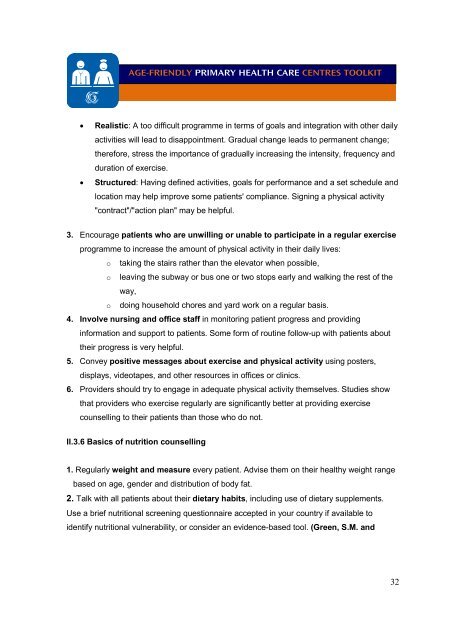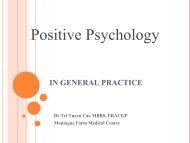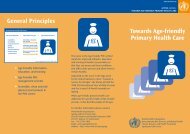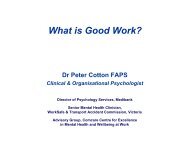Age-friendly Primary Health Care Centres Toolkit - World Health ...
Age-friendly Primary Health Care Centres Toolkit - World Health ...
Age-friendly Primary Health Care Centres Toolkit - World Health ...
- No tags were found...
You also want an ePaper? Increase the reach of your titles
YUMPU automatically turns print PDFs into web optimized ePapers that Google loves.
AGE-FRIENDLY PRIMARY HEALTH CARE CENTRES TOOLKIT• Realistic: A too difficult programme in terms of goals and integration with other dailyactivities will lead to disappointment. Gradual change leads to permanent change;therefore, stress the importance of gradually increasing the intensity, frequency andduration of exercise.• Structured: Having defined activities, goals for performance and a set schedule andlocation may help improve some patients' compliance. Signing a physical activity"contract"/"action plan" may be helpful.3. Encourage patients who are unwilling or unable to participate in a regular exerciseprogramme to increase the amount of physical activity in their daily lives:o taking the stairs rather than the elevator when possible,o leaving the subway or bus one or two stops early and walking the rest of theway,o doing household chores and yard work on a regular basis.4. Involve nursing and office staff in monitoring patient progress and providinginformation and support to patients. Some form of routine follow-up with patients abouttheir progress is very helpful.5. Convey positive messages about exercise and physical activity using posters,displays, videotapes, and other resources in offices or clinics.6. Providers should try to engage in adequate physical activity themselves. Studies showthat providers who exercise regularly are significantly better at providing exercisecounselling to their patients than those who do not.II.3.6 Basics of nutrition counselling1. Regularly weight and measure every patient. Advise them on their healthy weight rangebased on age, gender and distribution of body fat.2. Talk with all patients about their dietary habits, including use of dietary supplements.Use a brief nutritional screening questionnaire accepted in your country if available toidentify nutritional vulnerability, or consider an evidence-based tool. (Green, S.M. and32
















